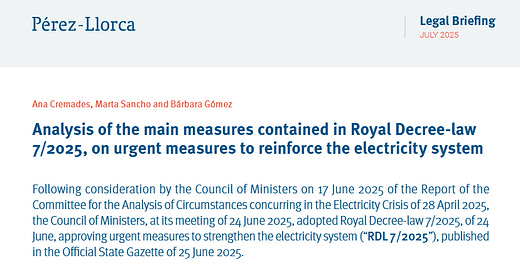Spanish Royal Decree-law on the blackout
Voltage controls for all generators, encouragement to add batteries, and more
Royal Decree-law 7/2025
A government body has investigated the outage of April 28, 2025. Their report went to the Council of Minsters in June 17, 2025. The Council of Ministers is implementing the committee’s recommencations by issueing Royal Decree-law 7/2025.
The law firm Pérez-Llorca has issued a sumary and posted it on the web. The authors are Ana Cremades, Marta Sancho, and Bárbara Gómez.
My post emphasizes technical points of interest to me. Please read the document at the link and draw your own conclusions. I am stating my opinion of as a reader of this publicly-available document.
Much of the text in Royal Decree-law 7/2025 is about changes in reporting, modification of the existing grid development plan, and management of the grid.
Here is a link to the Pérez-Llorca summary:
https://www.perezllorca.com/wp-content/uploads/2025/07/Legal-Briefing-Analysis-of-the-main-measures-contained-in-Royal-Decree-law-7-2025.pdf
Rusk summary
In my opinion the Royal Decree-law 7/2025 addresses these concerns:
Voltage Regulation
The need for better voltage regulation of traditional generators is addressed. Participation in voltage control by intevter-based resources is optional.
Encouragement of Batteries
One section is titled “Measures to promote energy storage.” Regulations are clarified and relaxed. The role of batteries in the order dispatching is changed so as to not penalize storage.
Shared Connections from Multiple Renewable Resources
Apparently Spain has locations where multiple solar, wind, and battery installations share a line to a substation. The approval process for the individual resources and the legal liability for any issues are made more clear.
Summary by Pérez-Llorca
Introduction
A Council of Ministers adopted Royal Decree-law 7/2025, abbreviated RDL 7/2025. It must be validated by the Congress of Deputies.
1. Reinforcement of the electricity system
A review of the operating procedures of the grid shows a need to strengthen voltage control. Penalties are increased for non-compliance with voltage control obligations. (Previous announcements said some of the traditional generators were operating outside the grid’s stated voltage limits.) Renewable energy production facilities can participate in the voltage control service and be reimbursed for their costs.
2. Measures affecting the development of electricity generation facilities
This section is primarily for renewable generation facilities which share a common line that connects to a substation. It establishes the legal responsibilities of all parties involved. They must sign an agreement. (Apparently there were one or more cases where responsibility for an issue could not be assigned and confusion arose.)
Repowering of a renewable facility is established as a legal concept. A repowering project of up to 25% increase receives expedited processing.
The differentiation between a Definitive Operating Permit and a Provisional Operating Permit for Testing, and what production, storage, and shared connection equipment is stated in more detail. (Confusion had arisen since production and storage equipment on shared connections had permits with varying implementation dates.)
A clarification was added that small batteries have the same exception as small generation facilities.
The process for approval of operation of generation facilities was clarified, especially a step called the Fifth Administrative Milestone.
The rules for the Specific Remuneration Regime was modified to reduce the required minimum operating hours when prices are zero or negative.
3. Measures to promote electricity storage
Changes to regulatory definitions and procedures are introduced to encourage storage facilities in general, and to especially encourage storage to be added to renewable generation facilities.
The order of priority in dispatching is changed to recognize storage as more valuable than before.
4. Flexibility and capacity mechanisms
The role of independent aggregators, self-consumption managers, and emergency groups is clarified.
5. Transmission grid planning
The timing of update reports and their contents are more clearly defined. A list of events is defined that require a review and possible update to the grid plan.
6. Measures related to electricity consumption
Changes to the plan for allowed connection points for users of electricity are defined. (Apparently with the goal of reducing places on the grid more subject to overload from the users of electricity.)
7. Other measures
Clarification of several regulations, including some regarding the charging of electric vehicles.



